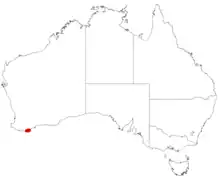| Leucopogon altissimus | |
|---|---|
| Scientific classification | |
| Kingdom: | Plantae |
| Clade: | Tracheophytes |
| Clade: | Angiosperms |
| Clade: | Eudicots |
| Clade: | Asterids |
| Order: | Ericales |
| Family: | Ericaceae |
| Genus: | Leucopogon |
| Species: | L. altissimus |
| Binomial name | |
| Leucopogon altissimus Hislop[1] | |
 | |
| Occurrence data from AVH | |
Leucopogon altissimus is a species of flowering plant in the heath family Ericaceae and is endemic to a restricted area in the south of Western Australia. It is a tall, erect shrub with glabrous branchlets, elliptic leaves and white or creamy-white flowers in groups in upper leaf axils or on the ends of branches.
Description
Leucopogon altissimus is an erect shrub that typically grows up to about 3 m (9.8 ft) high and 2 m (6 ft 7 in) wide, with a single stem at the base, its young branchlets glabrous. The leaves are elliptic, sometimes narrowly so, 22–48 mm (0.87–1.89 in) long and 6–13 mm (0.24–0.51 in) wide on a petiole up to 2 mm (0.079 in) long. The leaves are more or less flat and glabrous, the upper surface shiny and the lower surface a paler shade of green. The flowers are arranged in groups of seven to seventeen at the ends of branchlets, or in upper leaf axils, with egg-shaped bracts 0.8–1.4 mm (0.031–0.055 in) long and similar bracteoles, the sepals egg-shaped, 1.6–2.4 mm (0.063–0.094 in) long and greenish. The petals are joined at the base to form a bell-shaped tube shorter than the sepals, the lobes creamy-white and 1.6–2.1 mm (0.063–0.083 in) long. Flowering mainly occurs from August to October and the fruit is a glabrous, elliptic drupe 2.9–3.5 mm (0.11–0.14 in) long.[2][3]
Taxonomy and naming
Leucopogon altissimus was first formally described in 2008 by Michael Clyde Hislop in the journal Nuytsia from specimens he collected east of Albany in 2006.[2][4] The specific epithet (altissimus) means "highest".[5]
Distribution and habitat
This leucopogon mainly grows in a wide variety of habitats from sand dunes near the beach to dense heath on hilltops, but is only known from a small area between Two Peoples Bay, Cheyne Beach and Manypeaks in the Esperance Plains and Jarrah Forest biogeographic regions of southern Western Australia.[2][3]
Conservation status
Leucopogon altissimus is classified as "Priority Three" by the Government of Western Australia Department of Biodiversity, Conservation and Attractions,[3] meaning that it is poorly known and known from only a few locations but is not under imminent threat.[6]
References
- ↑ "Leucopogon altissimus". Australian Plant Census. Retrieved 10 May 2022.
- 1 2 3 Hislop, Michael C. (2008). "Three new species of Leucopogon (Ericaceae: Styphelioideae: Styphelieae) from the far south-west of Western Australia" (PDF). Nuytsia. 18: 65–67. Retrieved 10 May 2022.
- 1 2 3 "Leucopogon altissimus". FloraBase. Western Australian Government Department of Biodiversity, Conservation and Attractions.
- ↑ "Leucopogon altissimus". APNI. Retrieved 10 May 2022.
- ↑ Sharr, Francis Aubi; George, Alex (2019). Western Australian Plant Names and Their Meanings (3rd ed.). Kardinya, WA: Four Gables Press. pp. 130–131. ISBN 9780958034180.
- ↑ "Conservation codes for Western Australian Flora and Fauna" (PDF). Government of Western Australia Department of Parks and Wildlife. Retrieved 10 May 2022.
